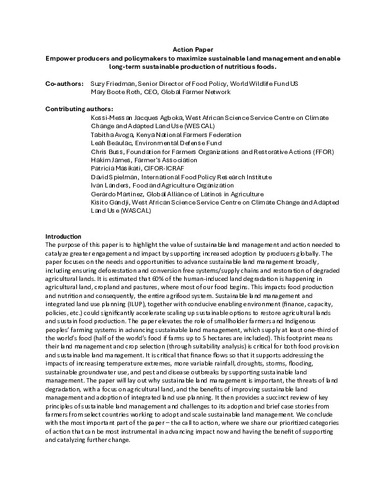Mostrar el registro sencillo del ítem
Empower producers and policymakers to maximize sustainable land management and enable long-term sustainable production of nutritious foods
| Creator: | Friedman, S. |
| Creator: | Boote Roth, M. |
| Creator: | Jacques Agboka, K. M. |
| Creator: | Avoga, T. |
| Creator: | Beaulac, L. |
| Creator: | Buss, C. |
| Creator: | James, H. |
| Creator: | Masikati, P. |
| Creator: | Spielman, D. J. |
| Creator: | Landers, I. |
| Creator: | Martinez, G. |
| Creator: | Kisito, Gandji |
| Fecha: | [2024} |
| URL: | https://hdl.handle.net/20.500.12665/4644 |
| Descripción: | The purpose of this paper is to highlight the value of sustainable land management and action needed to catalyze greater engagement and impact by supporting increased adoption by producers globally. The paper focuses on the needs and opportunities to advance sustainable land management broadly, including ensuring deforestation and conversion free systems/supply chains and restoration of degraded agricultural lands. It is estimated that 60% of the human-induced land degradation is happening in agricultural land, cropland and pastures, where most of our food begins. This impacts food production and nutrition and consequently, the entire agrifood system. Sustainable land management and integrated land use planning (ILUP), together with conducive enabling environment (finance, capacity, policies, etc.) could significantly accelerate scaling up sustainable options to restore agricultural lands and sustain food production. The paper elevates the role of smallholder farmers and Indigenous peoples’ farming systems in advancing sustainable land management, which supply at least one-third of the world’s food (half of the world’s food if farms up to 5 hectares are included). This footprint means their land management and crop selection (through suitability analysis) is critical for both food provision and sustainable land management. It is critical that finance flows so that it supports addressing the impacts of increasing temperature extremes, more variable rainfall, droughts, storms, flooding, sustainable groundwater use, and pest and disease outbreaks by supporting sustainable land management. The paper will lay out why sustainable land management is important, the threats of land degradation, with a focus on agricultural land, and the benefits of improving sustainable land management and adoption of integrated land use planning. It then provides a succinct review of key principles of sustainable land management and challenges to its adoption and brief case stories from farmers from select countries working to adopt and scale sustainable land management. We conclude with the most important part of the paper – the call to action, where we share our prioritized categories of action that can be most instrumental in advancing impact now and having the benefit of supporting and catalyzing further change. |
| Formato: | |
| Language: | English |
| Publisher: | CIMMYT |
| Rights: | CIMMYT manages Intellectual Assets as International Public Goods. The user is free to download, print, store and share this work. In case you want to translate or create any other derivative work and share or distribute such translation/derivative work, please contact CIMMYT-Knowledge-Center@cgiar.org indicating the work you want to use and the kind of use you intend; CIMMYT will contact you with the suitable license for that purpose |
| Tipo: | Action Paper |
| País: | Other |
| País: | United Republic of Tanzania |
| País: | India |
| País: | Malawi |
| País: | Philippines |
| País: | Latin America |
| País: | Kenya |
| Palabras Clave: | Sustainable land management |
| Palabras Clave: | Smallholders |
| Palabras Clave: | Agrifood systems |
| Palabras Clave: | Policies |
| Palabras Clave: | Access to finance |
Ficheros en el ítem
Este ítem aparece en la(s) siguiente(s) colección(ones)
-
Vision for Adapted Crops and Soils (VACS) [4]
A new partnership between the Food and Agriculture Organisation of the United Nations (FAO) and CIMMYT, a CGIAR Research Center, has marked a milestone through the Vision for Adapted Crops and Soils (VACS) initiative to build resilient agrifood systems grounded in diverse, nutritious and climate-adapted crops grown in healthy soils.

